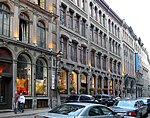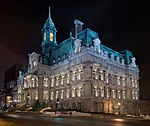Rue de la Commune
Cobbled streetsOld MontrealStreets in Montreal

Rue de la Commune (English: De la Commune Street) is a road in Old Montreal which is well used both by Montrealers and by tourists, since it is the home of the Pointe-à-Callière Museum and the Old Port of Montreal. The road follows the original shore of the Saint Lawrence River. The buildings along the north side of the road are former commercial buildings.
Excerpt from the Wikipedia article Rue de la Commune (License: CC BY-SA 3.0, Authors, Images).Rue de la Commune
Rue de la Commune Ouest, Montreal Ville-Marie
Geographical coordinates (GPS) Address Nearby Places Show on map
Geographical coordinates (GPS)
| Latitude | Longitude |
|---|---|
| N 45.505102 ° | E -73.553235 ° |
Address
Rue de la Commune Ouest 2
H2Y 2E1 Montreal, Ville-Marie
Quebec, Canada
Open on Google Maps











